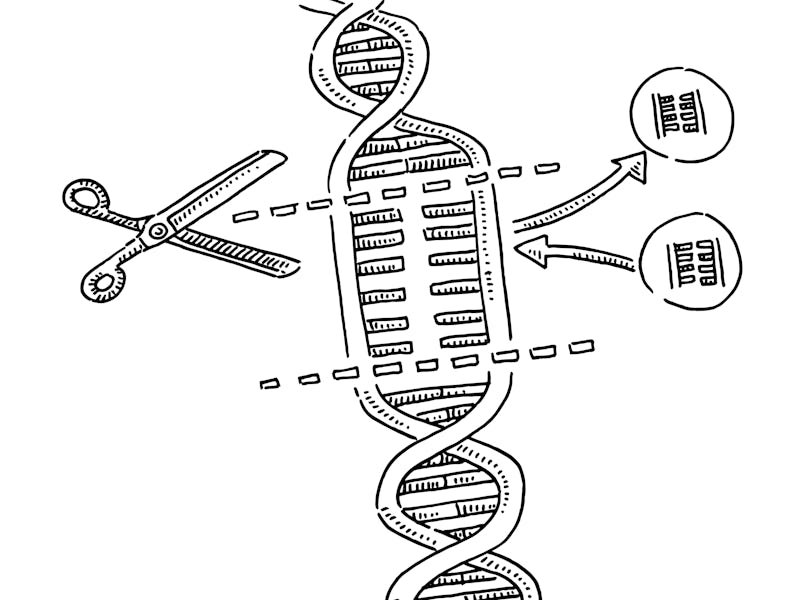Gene-edited "super dad" animals could help solve world hunger — study
"This shows the world that this technology is real. It can be used."

Nearly 700 million people around the world go to bed hungry every night, including the farmers, herdsmen, and fishermen who help produce 70 percent of the world's food while suffering from food insecurity themselves.
From a genetic perspective, a large obstacle facing these rural communities is that they lack access to modern animal husbandry tools that make precision breeding possible, like artificial insemination. Even with these tools, artificial insemination of "elite" genes in goats — the number one source of protein in the developing world — can be difficult without invasive surgery.
What could benefit this situation is CRISPR-Cas9, a gene-editing tool that can cut, copy, and paste sections of genetic material. Scientists argue that the tool could allow for a new, modern approach to animal husbandry, enabling farmers to breed only elite livestock without the need for artificial insemination.
This tool could help breed animals more resistant to disease and weather and could ultimately help create a more reliable food source for insecure communities. This finding was published Monday in the journal Proceedings of the National Academy of Sciences.
See also: Why 'Okja'-sized 6-ton pigs won't solve world hunger
Reproductive biologist and senior author Jon Oatley explains that, with this technology, "we can get better dissemination of desirable traits and improve the efficiency of food production."
"If we can tackle this genetically, then that means less water, less feed, and fewer antibiotics we have to put into the animals," Oately says.
Previous approaches to breeding donor-compatible surrogate livestock ran into a number of problems, Oately and his colleagues write. For example, while artificial insemination, a fairly common tool in husbandry that allows for selective breeding, has been fairly effective for more docile dairy cows, it has proven more difficult for beef cattle or goats. It can also be disruptive to the animals' natural breeding instincts.
Study lead, Jon Oatley, poses with a successful goat "surrogate sire"
Likewise, other approaches to surrogate husbandry, where a sterile male is implanted with more "elite" sperm, have used toxic sterilization drugs that caused the rejection of the sperm cells. By using CRISPR over a sterilization drug to breed sterile males, the team was finally able to demonstrate a proof-of-concept for this tool.
Here, "elite" is defined as genes that contribute to disease resistance, greater heat tolerance, and better meat quality.
"This shows the world that this technology is real. It can be used," Bruce Whitelaw, a co-author and animal physiology and genetics researcher at the Roslin Institute, explains. "We now have to go in and work out how best to use it productively to help feed our growing population."
How they did it — To actually pull off this feat, the researchers had CRISPR-Cas9 target and snip a tiny piece of genetic code responsible for male fertility in mice, goats, boar, and cattle: NANOS2.
By removing this piece of DNA, the team was able to breed naturally sterile, but otherwise healthy, male offspring for their surrogate experiments. From there, sterile males had elite sperm cells implanted into their testes and begun producing their own sperm based on those genetic instructions.
In their mice experiments, the researchers then introduced their new "super dads" to females to see how they got along. They observed that the males were able to reproduce and passed along their donor sperm DNA to their offspring. The researchers are still refining this approach for larger livestock but were able to successfully breed sterile goats and cattle using this CRISPR technique.
What's next — The researchers write that they're excited for the possibilities these early results promise for precision breeding, as well as for animal conservation. In the future, this technology could also be used to genetically modify diversity in endangered species and provide more opportunities for natural growth, the team says.
But, even with these important — albeit, a little eugenic — possibilities on the table, Oatley says that current public policies would not allow this technique to be used on food-chain animals, even if it reached commercialization. This is a concern that Oatley says conflates gene manipulation (which may alter how genes behave) with gene editing (which does not make changes that couldn't already naturally occur).
Facing this obstacle, as well as scientific obstacles of refining their approach, will be the next steps for this research.
"Even if all science is finished, the speed at which this can be put into action in livestock production anywhere in the world is going to be influenced by societal acceptance and federal policy," Oatley says. "By working with policymakers and the public, we can help to provide information assuring the public that this science does not carry the risks that other methods do."
Abstract: Spermatogonial stem cell transplantation (SSCT) is an experimental technique for transfer of germline between donor and recipient males that could be used as a tool for biomedical research, preservation of endangered species, and dissemination of desirable genetics in food animal populations. To fully realize these potentials, recipient males must be devoid of endogenous germline but possess normal testicular architecture and somatic cell function capable of supporting allogeneic donor stem cell engraftment and regeneration of spermatogenesis. Here we show that male mice, pigs, goats, and cattle harboring knockout alleles of the NANOS2 gene generated by CRISPR-Cas9 editing have testes that are germline ablated but otherwise structurally normal. In adult pigs and goats, SSCT with allogeneic donor stem cells led to sustained donor-derived spermatogenesis. With prepubertal mice, allogeneic SSCT resulted in attainment of natural fertility. Collectively, these advancements represent a major step toward realizing the enormous potential of surrogate sires as a tool for dissemination and regeneration of germplasm in all mammalian species.
This article was originally published on